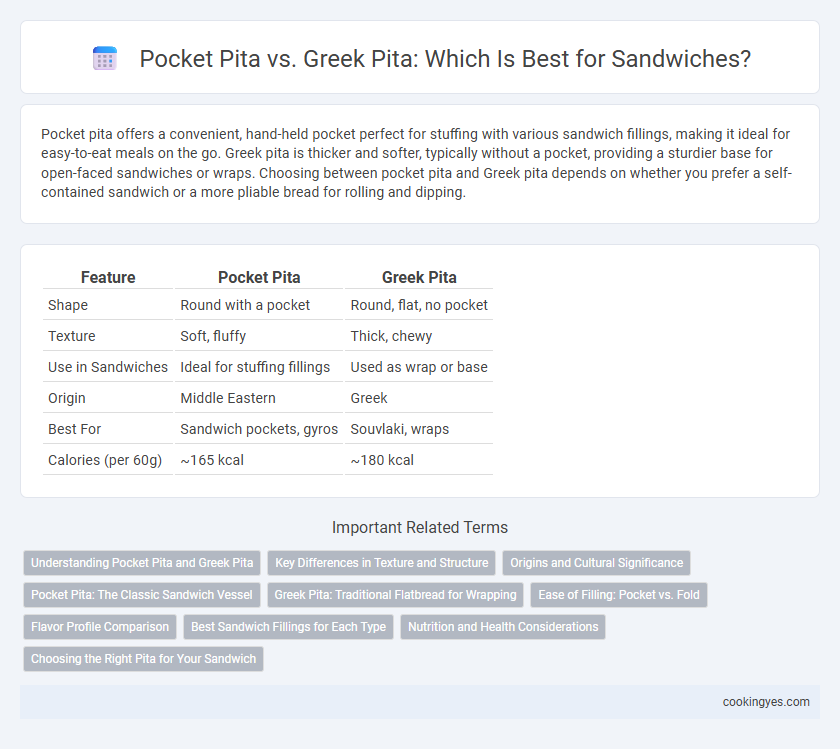Pocket pita offers a convenient, hand-held pocket perfect for stuffing with various sandwich fillings, making it ideal for easy-to-eat meals on the go. Greek pita is thicker and softer, typically without a pocket, providing a sturdier base for open-faced sandwiches or wraps. Choosing between pocket pita and Greek pita depends on whether you prefer a self-contained sandwich or a more pliable bread for rolling and dipping.
Table of Comparison
| Feature | Pocket Pita | Greek Pita |
|---|---|---|
| Shape | Round with a pocket | Round, flat, no pocket |
| Texture | Soft, fluffy | Thick, chewy |
| Use in Sandwiches | Ideal for stuffing fillings | Used as wrap or base |
| Origin | Middle Eastern | Greek |
| Best For | Sandwich pockets, gyros | Souvlaki, wraps |
| Calories (per 60g) | ~165 kcal | ~180 kcal |
Understanding Pocket Pita and Greek Pita
Pocket pita features a hollow interior perfect for stuffing with sandwich fillings, offering a convenient and mess-free eating experience. Greek pita is typically thicker and fluffier, lacking a pocket but known for its soft texture and slightly chewy bite, ideal for wrapping or dipping. Choosing between pocket pita and Greek pita depends on the sandwich style and personal preference for texture and filling containment.
Key Differences in Texture and Structure
Pocket pita features a hollow interior that creates a convenient pocket ideal for stuffing sandwiches, while Greek pita is typically thicker and fluffier without a pocket, making it better suited for wraps or as a side. The texture of pocket pita is softer and more pliable, designed to hold fillings without tearing, whereas Greek pita has a denser, chewier texture, offering a more substantial bite. Structurally, pocket pita's pocket forms during baking due to steam separation, contrasting with Greek pita's solid, flat profile that maintains its shape without an internal cavity.
Origins and Cultural Significance
Pocket pita, originating from Middle Eastern cuisine, features a hollow center ideal for stuffing with fillings, reflecting its practical design for portable meals in ancient Levantine cultures. Greek pita, thicker and softer without a pocket, evolved as a staple in Mediterranean diets, often served alongside dishes like souvlaki and gyros, highlighting communal dining traditions. Both varieties showcase distinct culinary histories that shape their cultural significance and sandwich-making uses worldwide.
Pocket Pita: The Classic Sandwich Vessel
Pocket pita offers a versatile and practical choice for sandwiches, featuring a hollow interior that securely holds fillings like grilled meats, vegetables, and sauces without spilling. Its soft, slightly chewy texture enhances the eating experience while maintaining flexibility to accommodate diverse sandwich ingredients. Unlike Greek pita, which is usually flat without a pocket, pocket pita's structure makes it ideal for handheld sandwiches, preserving flavor and convenience.
Greek Pita: Traditional Flatbread for Wrapping
Greek pita, characterized by its soft, pliable texture and slightly thicker form, serves as the traditional flatbread ideal for wrapping sandwiches with a variety of fillings. Unlike pocket pita, Greek pita lacks a hollow center, which allows it to hold ingredients securely without spillage while providing a hearty, chewy bite. This flatbread's neutral flavor profile enhances the overall taste of Mediterranean-style sandwiches, making it a versatile choice for gyros, souvlaki, and vegetable wraps.
Ease of Filling: Pocket vs. Fold
Pocket pita offers superior ease of filling due to its hollow interior, allowing ingredients to be neatly stuffed inside without spillage. Greek pita, typically flat and flexible, requires folding which can cause fillings to slip out and demands more careful handling. For sandwich preparation, pocket pita ensures a mess-free experience, making it ideal for containing bulky or juicy fillings.
Flavor Profile Comparison
Pocket pita features a soft, slightly chewy texture with a mild, subtly sweet flavor that complements a variety of sandwich fillings without overpowering them. Greek pita offers a richer, tangier taste with a denser crumb and a hint of sourness from the natural fermentation process, enhancing bold and savory ingredients. Both pitas deliver unique flavor experiences that influence the overall taste of sandwiches depending on the filling and personal preference.
Best Sandwich Fillings for Each Type
Pocket pita offers a convenient pocket ideal for stuffed sandwich fillings like falafel, grilled chicken, or gyro meat combined with fresh vegetables and creamy tzatziki, maximizing flavor and ease of eating. Greek pita, characterized by its flat and slightly chewy texture, complements open-faced sandwiches with ingredients such as sliced lamb, feta cheese, olives, tomatoes, and cucumbers, providing a balanced Mediterranean taste. Choosing pocket pita enhances portability and neatness, while Greek pita excels in showcasing layered fillings with vibrant Mediterranean flavors.
Nutrition and Health Considerations
Pocket pita provides a convenient, low-calorie option with typical servings containing around 150 calories and 30 grams of carbohydrates, suitable for portion control in sandwiches. Greek pita tends to be thicker and denser, often delivering more fiber and protein per serving, which supports longer satiety and digestive health. Choosing between pocket and Greek pita depends on balancing calorie intake with nutritional benefits such as fiber content and whole grain availability.
Choosing the Right Pita for Your Sandwich
Pocket pita features a hollow center ideal for stuffing with meats, vegetables, and sauces, making it perfect for portable, handheld sandwiches like falafel or gyros. Greek pita is thicker, softer, and without a pocket, offering a pliable base for open-faced sandwiches and wraps that hold ingredients without spilling. Selecting between pocket and Greek pita depends on whether you prefer a stuffed sandwich that stays contained or an open style that showcases layered fillings.
Pocket pita vs Greek pita for sandwiches Infographic

 cookingyes.com
cookingyes.com